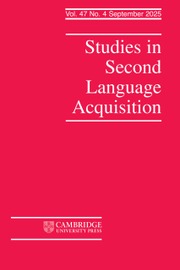No CrossRef data available.
Article contents
Usage-based analysis of L2 oral proficiency: Characteristics of argument structure construction use
Published online by Cambridge University Press: 04 August 2025
Abstract
Analyzing the relationship between argument structure construction (ASC) use and language learning has been an important area of investigation in second language (L2) studies from a usage-based constructionist approach. Previous studies have shown that advanced L2 learners’ language use demonstrates greater ASC diversity, less frequent ASC-verb combinations, and stronger ASC-verb associations. However, these investigations have been limited by methodological challenges in identifying ASCs and have predominantly focused on the written texts. To address these limitations, we employ a fine-tuned model to automatically extract ASCs from target and reference corpora, considering their semantic aspects. We then calculate ASC-based indices and, both alone and in combination with other lexicogrammatical indices, use them to predict L2 oral proficiency scores assigned by human judges. Our findings show that ASC-based indices alone explain 44% of the variance in scores. When combined with other indices, they provide complementary insights that enhance multivariate modeling of L2 oral proficiency.
Keywords
Information
- Type
- Research Article
- Information
- Open Practices
Open data
Open materials
Preregistered
- Copyright
- © The Author(s), 2025. Published by Cambridge University Press


